Has The Attractiveness And Sex Partners Correlation Increased?
A contention I’ve encountered in response to data on attractiveness/height and mating outcomes I’ve presented is that it understates the effect as it’s not up to date enough to be relevant, with the reasoning generally being that dating apps have dramatically altered the playing field, leading to what can be summed up as the ‘Tinder-driven chadopoly’.
I’ve shown already that the most promiscuous men in general aren’t getting more promiscuous, but it remains possible that their promiscuity may be more dependent on physical attractiveness than it was before the introduction of dating apps which encourage snap judgments based on little more than a few images. In the black pill worldview dating and attraction never really goes beyond this anyway, so I guess in that case the focus would be on the discretion and ease of access that they enable.
This is an empirically testable hypothesis. If it is indeed the case that dating apps have facilitated a radical shift in dating culture toward women all hopping on the top 1% chadrone c*ck carousel, then the correlation between attractiveness and sexual partners should have definitely been amplified along with their rise.
First, a meta-analysis of studies conducted before Tinder took off yields a summary effect size of .15.
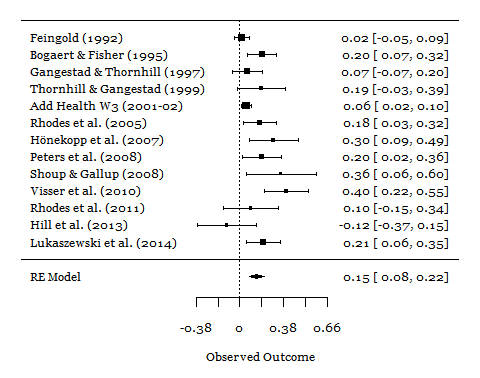
Now, I have collected the most recent studies containing relevant information and included some analyses of GSS data. I selected heterosexual 18-35 men and correlated their interviewer-rated looks with their reported sex partners in the past year as more recent partners are more likely to have been encountered on dating apps.
The correlations for Kordsmeyer et al. (2018) are also for the past year, the second one from a follow-up study 18 months later. For Foo et al. (2017) it was lifetime sexual partners. The mean ages were 24.2 and 20.8 respectively. The ratings were made by a group of opposite-sex judges in Foo et al. and a mixed gender group in Kordsmeyer et al., though men’s video-rated sexual attractiveness rated by a female only group showed the same results.
With that out of the way, how much has this changed post-Tinder? Nada. The estimate is virtually identical.
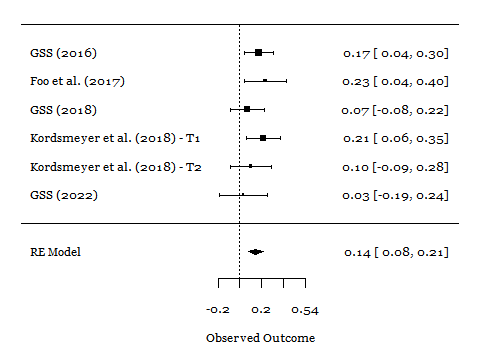
The partners in the past year measure may have less room for variance so let’s look at the longer term counts for good measure. In the 2018 GSS attractiveness correlated at .07 with partners in the past 5 years and .09 with number of partners since 18. In Kordsmeyer et al. it correlated at .11 with total one-night stand partners and .06 with total sex partners without interest in a long-term committed relationship in T1, and .01 and .04 in T2 (sample was reduced somewhat). In the 2022 GSS it correlated at .18 with partners in the past 5 years and -.19 with lifetime partners. The correlations remain small no matter how you slice it.
The association between height and sex partners also remains trivial.
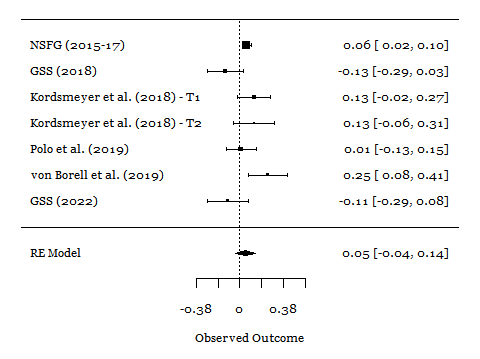
So, not only is the meme of an intensifying sexual skew not supported by the data, there is also no evidence that the variance that does exist is now more influenced by attractiveness or height than it was before dating apps supposedly destroyed the chances of all but the most physically superior specimens.
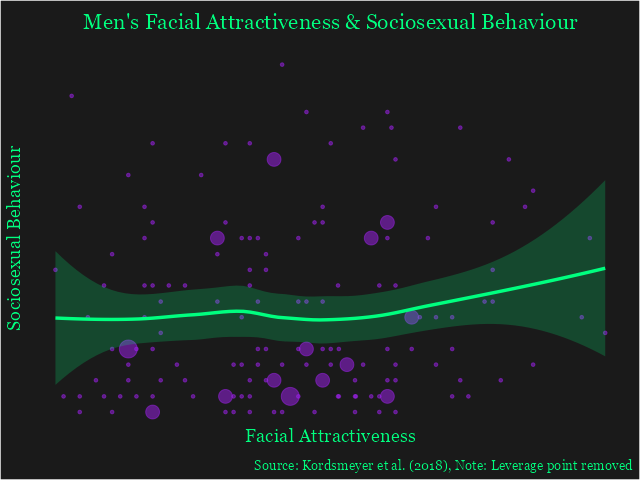
If there has been no change, then why is this such a pervasive belief which has spilled well beyond the confines of incel ideology? What is causing this mass delusion? I guess the simple reason is that the gender dynamics of dating apps create a powerful perception which is reinforced by a continuous stream of ‘chadfish experiments’, rageposts, and so on. As the media has been pushing the narrative of a male-driven sexlessness/singleness crisis a lot lately (I won’t reiterate how a more thorough analysis raises serious doubts about this) this has demanded an explanation, and this is one that inevitably pops up a lot. I won’t reiterate everything in my post on the dating app meme either, but as with many surface level intuitions, it’s not as straightforward as it might seem.
People often see Tinder is often seen as Grindr for straight people, so if most guys aren’t hooking up much through it then I guess the conclusion is that elite minority must be having all those missing hookups. This notion is especially strong among incels who are more on the autistic side and tend to project men’s higher short-term orientation onto women due to lacking a robust theory of mind.
A paper by Harrison et al. (2022) however cast further doubt on the popular notion that they’re a hookup facilitator however, finding in their regression model that the love motive but not the hookup motive or sensation seeking was a predictor of having met a match in person. Consistent with other data there was also no effect of gender, and while men reported a much higher hookup motive than did women, they also reported a relationship motive at least as high.
Phone apps haven’t suddenly dissolved the sex differences in sociosexuality and horniness, and women aren’t simply gay men but more selective. You could argue that it happens in a more subtle way, such that men lead women on by feigning interest in a committed relationship while the women keep getting burnt because they refuse to settle for their ‘looksmatch’, but this probably overestimates how many ‘chads’ are manipulative dark triad types (you could argue this is a misandristic assumption) and also how many women fall for it so quickly. Even of the men who are theoretically willing to do this, most of them would probably prefer to simply find a steady partner of similar attractiveness rather than go through that song and dance just to add some notches to their belt.
It’s also not like there was no way to discriminate on the basis of looks before dating apps existed, or that women would’ve somehow needed to expand their selection pool to thousands of men to find this elusive chad, unless he is now defined as being in the top 0.1% of attractiveness.
As small as it may be we do see an effect of attractiveness on sociosexual behaviour for men, so it’s not like there’s no room for this to ever happen or for a man to have a consensual hookup with a more promiscuous woman who is perhaps below his attractiveness level, but we can safely say that it’s not happening any more than it did before apps came onto the scene.
References
Feingold, A. (1992). Gender differences in mate selection preferences: A test of the parental investment model. Psychological Bulletin, 112(1), 125–139. https://doi.org/10.1037/0033-2909.112.1.125
Bogaert, A. F., & Fisher, W. A. (1995). Predictors of university men’s number of sexual partners. Journal of Sex Research, 32(2), 119–130. https://doi.org/10.1080/00224499509551782
Gangestad, S. W., & Thornhill, R. (1997). Human sexual selection and developmental stability. In J. A. Simpson & D. T. Kenrick (Eds.), Evolutionary social psychology (pp. 169–196). Lawrence Erlbaum Associates, Inc.
Thornhill, R., & Gangestad, S. W. (1999). The scent of symmetry: A human sex pheromone that signals fitness? Evolution and Human Behavior, 20(3), 175–201. https://doi.org/10.1016/S1090-5138(99)00005-7
Rhodes, G., Simmons, L. W., & Peters, M. (2005b). Attractiveness and sexual behavior: Does attractiveness enhance mating success? Evolution and Human Behavior, 26(2), 186–201. https://doi.org/10.1016/j.evolhumbehav.2004.08.014
Hönekopp, J., Rudolph, U., Beier, L., Liebert, A., & Müller, C. (2007). Physical attractiveness of face and body as indicators of physical fitness in men. Evolution and Human Behavior, 28(2), 106–111. https://doi.org/10.1016/j.evolhumbehav.2006.09.001
Peters, M., Rhodes, G., & Simmons, L. W. (2008). Does attractiveness in men provide clues to semen quality? Journal of Evolutionary Biology, 21(2), 572–579. https://doi.org/10.1111/j.1420-9101.2007.01477.x
Shoup, M. L., & Gallup, G. G., Jr. (2008). Men’s faces convey information about their bodies and their behavior: What you see is what you get. Evolutionary Psychology, 6(3), 469–479. https://doi.org/10.1177/147470490800600311
Visser, B. A., Pozzebon, J. A., Bogaert, A. F., & Ashton, M. C. (2010). Psychopathy, sexual behavior, and esteem: It’s different for girls. Personality and Individual Differences, 48(7), 833–838. https://doi.org/10.1016/j.paid.2010.02.008
Rhodes, G., Lie, H. C., Thevaraja, N., Taylor, L., Iredell, N., Curran, C., Tan, S. Q. C., Carnemolla, P., & Simmons, L. W. (2011). Facial Attractiveness Ratings from Video-Clips and Static Images Tell the Same Story. PLOS ONE, 6(11), e26653. https://doi.org/10.1371/journal.pone.0026653
Hill, A. K., Hunt, J., Welling, L. L. M., Cárdenas, R. A., Rotella, M. A., Wheatley, J. R., Dawood, K., Shriver, M. D., & Puts, D. A. (2013b). Quantifying the strength and form of sexual selection on men’s traits. Evolution and Human Behavior, 34(5), 334–341. https://doi.org/10.1016/j.evolhumbehav.2013.05.004
Foo, Y. Z., Simmons, L. W., & Rhodes, G. (2017). Predictors of facial attractiveness and health in humans. Scientific reports, 7, 39731. https://doi.org/10.1038/srep39731
Kordsmeyer, T. L., Hunt, J., Puts, D. A., Ostner, J., & Penke, L. (2018c). The relative importance of intra- and intersexual selection on human male sexually dimorphic traits. Evolution and Human Behavior, 39(4), 424–436. https://doi.org/10.1016/j.evolhumbehav.2018.03.008
Polo, P., Muñoz-Reyes, J. A., Pita, M., Shackelford, T. K., & Fink, B. (2019). Testosterone-dependent facial and body traits predict men’s sociosexual attitudes and behaviors. American journal of human biology : the official journal of the Human Biology Council, 31(3), e23235. https://doi.org/10.1002/ajhb.23235
Von Borell, C. J., Kordsmeyer, T. L., Gerlach, T. M., & Penke, L. (2019). An integrative study of facultative personality calibration. Evolution and Human Behavior, 40(2), 235–248. https://doi.org/10.1016/j.evolhumbehav.2019.01.002
Harrison, M. G., McAnulty, R. D., & Canevello, A. (2022). College Students’ Motives for In-Person Meetings with Dating Application Matches. Cyberpsychology, behavior and social networking, 25(2), 130–134. https://doi.org/10.1089/cyber.2021.0031

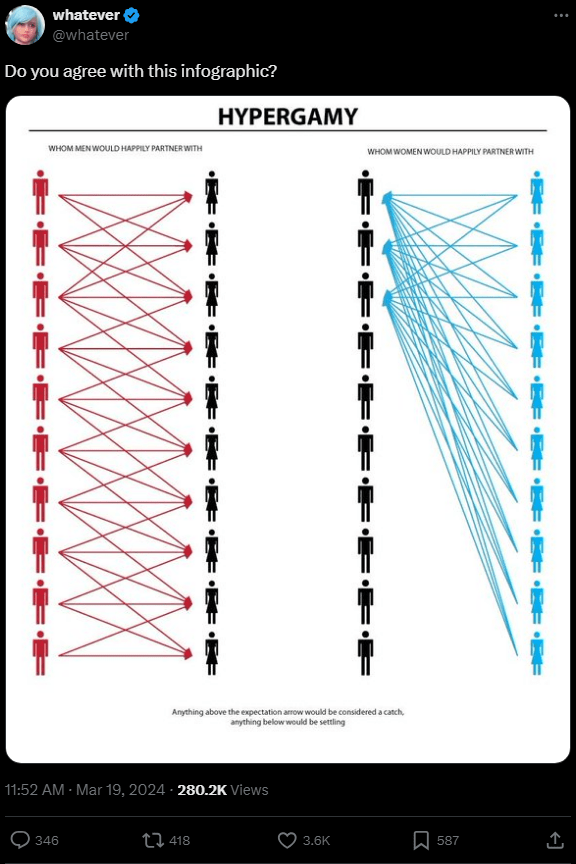
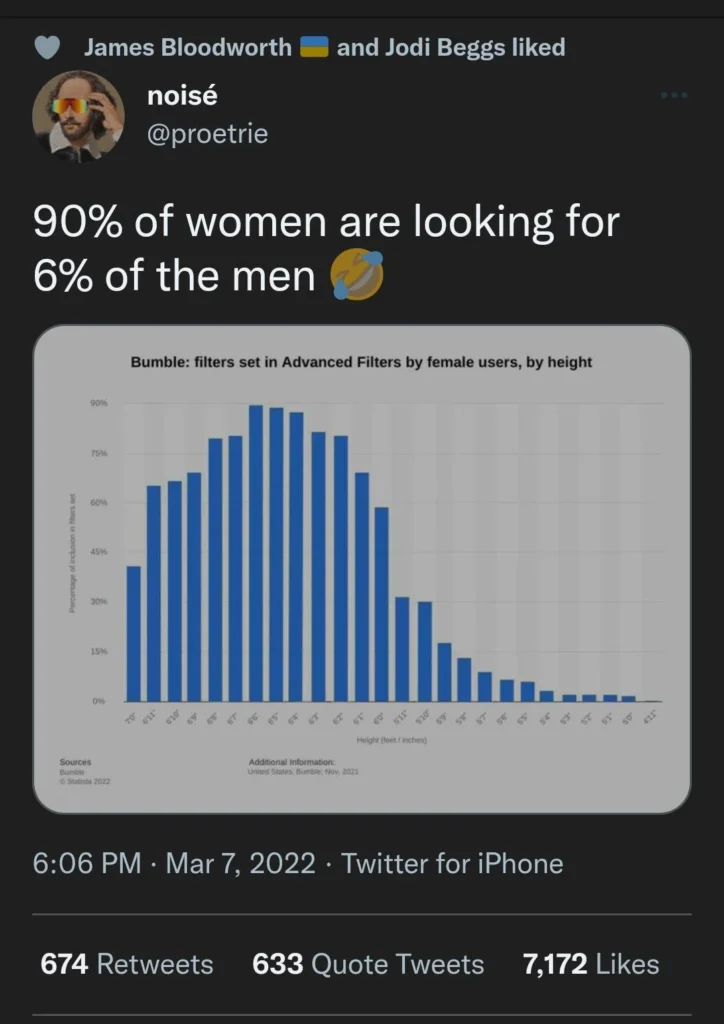
Ive read several just right stuff here Certainly price bookmarking for revisiting I wonder how a lot effort you place to create this kind of great informative website
Hello my loved one I want to say that this post is amazing great written and include almost all significant infos I would like to look extra posts like this
Your posts always provide me with a new perspective and encourage me to look at things differently Thank you for broadening my horizons
Your posts always provide me with a new perspective and encourage me to look at things differently Thank you for broadening my horizons
Your posts always provide me with a new perspective and encourage me to look at things differently Thank you for broadening my horizons
Your posts always provide me with a new perspective and encourage me to look at things differently Thank you for broadening my horizons
I have recommended your blog to all of my friends and family Your words have the power to change lives and I want others to experience that as well
Revolutionize Your Farming Practices with Bwer Pipes: Discover the power of Bwer Pipes’ advanced irrigation solutions for agricultural success in Iraq. Our innovative sprinkler systems and durable pipes are engineered to optimize water usage, improve crop health, and boost yields, helping farmers thrive in challenging environments. Explore Bwer Pipes
I do not even know how I ended up here but I thought this post was great I dont know who you are but definitely youre going to a famous blogger if you arent already Cheers
Magnificent beat I would like to apprentice while you amend your site how can i subscribe for a blog web site The account helped me a acceptable deal I had been a little bit acquainted of this your broadcast offered bright clear idea
Ive read several just right stuff here Certainly price bookmarking for revisiting I wonder how a lot effort you place to create this kind of great informative website
에그슬롯
집에서 편안하게 차를 마시던 팡지판은 다시 궁으로 급히 들어갔다.
더 트위티 하우스
이에 대해 Fengtian Palace의 많은 장관들이 감동했습니다.
황제 슬롯
Hongzhi 황제는 무의식적으로 Liu Jian과 다른 사람들을 바라 보았습니다.
Hi my loved one I wish to say that this post is amazing nice written and include approximately all vital infos Id like to peer more posts like this
Hi i think that i saw you visited my web site thus i came to Return the favore I am attempting to find things to improve my web siteI suppose its ok to use some of your ideas
Nice blog here Also your site loads up fast What host are you using Can I get your affiliate link to your host I wish my web site loaded up as quickly as yours lol
I simply could not go away your web site prior to suggesting that I really enjoyed the standard info a person supply on your guests Is going to be back incessantly to investigate crosscheck new posts
Fantastic beat I would like to apprentice while you amend your web site how could i subscribe for a blog site The account helped me a acceptable deal I had been a little bit acquainted of this your broadcast offered bright clear concept
Hello my loved one I want to say that this post is amazing great written and include almost all significant infos I would like to look extra posts like this
I loved as much as you will receive carried out right here The sketch is attractive your authored material stylish nonetheless you command get got an impatience over that you wish be delivering the following unwell unquestionably come more formerly again since exactly the same nearly a lot often inside case you shield this hike
Every time I visit your website, I’m greeted with thought-provoking content and impeccable writing. You truly have a gift for articulating complex ideas in a clear and engaging manner.
obviously like your website but you need to test the spelling on quite a few of your posts Several of them are rife with spelling problems and I to find it very troublesome to inform the reality on the other hand Ill certainly come back again
The degree to which I appreciate your creations is equal to your own sentiment. Your sketch is tasteful, and the authored material is stylish. Yet, you seem uneasy about the prospect of embarking on something that may cause unease. I agree that you’ll be able to address this matter efficiently.
Attractive section of content I just stumbled upon your blog and in accession capital to assert that I get actually enjoyed account your blog posts Anyway I will be subscribing to your augment and even I achievement you access consistently fast
Normalmente eu não leio artigos em blogs, mas gostaria de dizer que este artigo me obrigou muito a dar uma olhada e fazê-lo. Seu estilo de escrita me surpreendeu. Obrigado, artigo muito bom
Temp mail I appreciate you sharing this blog post. Thanks Again. Cool.
Its like you read my mind You appear to know so much about this like you wrote the book in it or something I think that you can do with a few pics to drive the message home a little bit but other than that this is fantastic blog A great read Ill certainly be back
É como se você lesse minha mente Você parece saber muito sobre isso, como se tivesse escrito o livro nele ou algo assim. Acho que você pode fazer com algumas fotos para transmitir um pouco a mensagem, mas em vez disso, este é um excelente blog A leitura fantástica, certamente voltarei
obviously like your website but you need to test the spelling on quite a few of your posts Several of them are rife with spelling problems and I to find it very troublesome to inform the reality on the other hand Ill certainly come back again
Gia Lai Tech On community orbitonline com – Khám phá những liên kết hữu ích đưa bạn đến trang chủ của Gia Lai Tech – Blog Công Nghệ Hàng Đầu Gia Lai
Usually I do not read article on blogs however I would like to say that this writeup very compelled me to take a look at and do so Your writing taste has been amazed me Thanks quite nice post
ремонт iphone сервисный центр
ремонт смартфонов
Usually I do not read article on blogs however I would like to say that this writeup very compelled me to take a look at and do it Your writing style has been amazed me Thank you very nice article
ремонт матрицы телевизора цена
Профессиональный сервисный центр по ремонту сотовых телефонов, смартфонов и мобильных устройств.
Мы предлагаем: сервисный центр по ремонту телефонов
Наши мастера оперативно устранят неисправности вашего устройства в сервисе или с выездом на дом!
Профессиональный сервисный центр по ремонту сотовых телефонов, смартфонов и мобильных устройств.
Мы предлагаем: ремонтная мастерская телефонов
Наши мастера оперативно устранят неисправности вашего устройства в сервисе или с выездом на дом!
Профессиональный сервисный центр по ремонту ноутбуков, макбуков и другой компьютерной техники.
Мы предлагаем:сервис макбук в москве
Наши мастера оперативно устранят неисправности вашего устройства в сервисе или с выездом на дом!
Профессиональный сервисный центр по ремонту квадрокоптеров и радиоуправляемых дронов.
Мы предлагаем:сервис по ремонту квадрокоптеров
Наши мастера оперативно устранят неисправности вашего устройства в сервисе или с выездом на дом!
Internet Chicks There is definately a lot to find out about this subject. I like all the points you made
Your blog is a breath of fresh air in the often stagnant world of online content. Your thoughtful analysis and insightful commentary never fail to leave a lasting impression. Thank you for sharing your wisdom with us.
Профессиональный сервисный центр по ремонту ноутбуков, imac и другой компьютерной техники.
Мы предлагаем:ремонт аймаков
Наши мастера оперативно устранят неисправности вашего устройства в сервисе или с выездом на дом!
Профессиональный сервисный центр по ремонту ноутбуков и компьютеров.дронов.
Мы предлагаем:сервисный центр по ремонту ноутбуков в москве
Наши мастера оперативно устранят неисправности вашего устройства в сервисе или с выездом на дом!
сервис центр apple
I loved as much as you will receive carried out right here The sketch is tasteful your authored subject matter stylish nonetheless you command get got an edginess over that you wish be delivering the following unwell unquestionably come further formerly again as exactly the same nearly very often inside case you shield this hike
ремонт apple watch
Профессиональный сервисный центр по ремонту холодильников и морозильных камер.
Мы предлагаем: ремонт холодильников на дому
Наши мастера оперативно устранят неисправности вашего устройства в сервисе или с выездом на дом!
Профессиональный сервисный центр по ремонту планетов в том числе Apple iPad.
Мы предлагаем: ремонт айпадов с гарантией
Наши мастера оперативно устранят неисправности вашего устройства в сервисе или с выездом на дом!
Профессиональный сервисный центр по ремонту ноутбуков и компьютеров.дронов.
Мы предлагаем:ремонт ноутбуков москва центр
Наши мастера оперативно устранят неисправности вашего устройства в сервисе или с выездом на дом!
Профессиональный сервисный центр по ремонту бытовой техники с выездом на дом.
Мы предлагаем:ремонт бытовой техники в спб
Наши мастера оперативно устранят неисправности вашего устройства в сервисе или с выездом на дом!
Если вы искали где отремонтировать сломаную технику, обратите внимание – выездной ремонт бытовой техники в петербурге
Профессиональный сервисный центр по ремонту радиоуправляемых устройства – квадрокоптеры, дроны, беспилостники в том числе Apple iPad.
Мы предлагаем: ремонт квадрокоптеров
Наши мастера оперативно устранят неисправности вашего устройства в сервисе или с выездом на дом!
Если вы искали где отремонтировать сломаную технику, обратите внимание – ремонт бытовой техники в екб
Если вы искали где отремонтировать сломаную технику, обратите внимание – профи ремонт
Если вы искали где отремонтировать сломаную технику, обратите внимание – ремонт бытовой техники
Профессиональный сервисный центр по ремонту Apple iPhone в Москве.
Мы предлагаем: срочный ремонт iphone в москве
Наши мастера оперативно устранят неисправности вашего устройства в сервисе или с выездом на дом!
ремонт телефонов
ремонт телевизора на дому в москве
Профессиональный сервисный центр по ремонту источников бесперебойного питания.
Мы предлагаем: ремонт плат ибп
Наши мастера оперативно устранят неисправности вашего устройства в сервисе или с выездом на дом!
Если вы искали где отремонтировать сломаную технику, обратите внимание – ремонт бытовой техники
Если вы искали где отремонтировать сломаную технику, обратите внимание – профи тех сервис челябинск
Профессиональный сервисный центр по ремонту варочных панелей и индукционных плит.
Мы предлагаем: ремонт варочных панелей с гарантией
Наши мастера оперативно устранят неисправности вашего устройства в сервисе или с выездом на дом!
Профессиональный сервисный центр по ремонту бытовой техники с выездом на дом.
Мы предлагаем:сервисные центры по ремонту техники в екб
Наши мастера оперативно устранят неисправности вашего устройства в сервисе или с выездом на дом!
Just wish to say your article is as surprising The clearness in your post is just cool and i could assume youre an expert on this subject Fine with your permission allow me to grab your RSS feed to keep updated with forthcoming post Thanks a million and please keep up the enjoyable work
замена матрицы в фотоаппарате
Если вы искали где отремонтировать сломаную технику, обратите внимание – сервис центр в челябинске
Профессиональный сервисный центр по ремонту фото техники от зеркальных до цифровых фотоаппаратов.
Мы предлагаем: замена матрицы в фотоаппарате
Наши мастера оперативно устранят неисправности вашего устройства в сервисе или с выездом на дом!
Если вы искали где отремонтировать сломаную технику, обратите внимание – профи тех сервис краснодар
Профессиональный сервисный центр по ремонту планшетов в Москве.
Мы предлагаем: ремонт планшетников
Наши мастера оперативно устранят неисправности вашего устройства в сервисе или с выездом на дом!
Профессиональный сервисный центр по ремонту бытовой техники с выездом на дом.
Мы предлагаем:ремонт крупногабаритной техники в новосибирске
Наши мастера оперативно устранят неисправности вашего устройства в сервисе или с выездом на дом!
Simply Sseven This was beautiful Admin. Thank you for your reflections.
Если вы искали где отремонтировать сломаную технику, обратите внимание – ремонт бытовой техники
Профессиональный сервисный центр по ремонту видео техники а именно видеокамер.
Мы предлагаем: ремонт цифровых видеокамер
Наши мастера оперативно устранят неисправности вашего устройства в сервисе или с выездом на дом!
Если вы искали где отремонтировать сломаную технику, обратите внимание – ремонт техники в красноярске
Профессиональный сервисный центр по ремонту бытовой техники с выездом на дом.
Мы предлагаем: ремонт бытовой техники в москве
Наши мастера оперативно устранят неисправности вашего устройства в сервисе или с выездом на дом!
Если вы искали где отремонтировать сломаную технику, обратите внимание – тех профи
Если вы искали где отремонтировать сломаную технику, обратите внимание – ремонт бытовой техники в новосибирске
Профессиональный сервисный центр по ремонту стиральных машин с выездом на дом по Москве.
Мы предлагаем: сервисные центры по ремонту стиральных машин
Наши мастера оперативно устранят неисправности вашего устройства в сервисе или с выездом на дом!
Профессиональный сервисный центр по ремонту бытовой техники с выездом на дом.
Мы предлагаем: сервис центры бытовой техники казань
Наши мастера оперативно устранят неисправности вашего устройства в сервисе или с выездом на дом!
Если вы искали где отремонтировать сломаную технику, обратите внимание – ремонт бытовой техники в перми
Профессиональный сервисный центр по ремонту бытовой техники с выездом на дом.
Мы предлагаем: сервисные центры по ремонту техники в москве
Наши мастера оперативно устранят неисправности вашего устройства в сервисе или с выездом на дом!
Профессиональный сервисный центр по ремонту бытовой техники с выездом на дом.
Мы предлагаем: сервис центры бытовой техники москва
Наши мастера оперативно устранят неисправности вашего устройства в сервисе или с выездом на дом!
Если вы искали где отремонтировать сломаную технику, обратите внимание – выездной ремонт бытовой техники в ростове на дону
Профессиональный сервисный центр по ремонту игровых консолей Sony Playstation, Xbox, PSP Vita с выездом на дом по Москве.
Мы предлагаем: ремонт игровых консолей с гарантией
Наши мастера оперативно устранят неисправности вашего устройства в сервисе или с выездом на дом!
Профессиональный сервисный центр по ремонту компьютерных видеокарт по Москве.
Мы предлагаем: [url=remont-videokart-gar.ru]ремонт видеокарты в москве[/url]
Наши мастера оперативно устранят неисправности вашего устройства в сервисе или с выездом на дом!
Профессиональный сервисный центр по ремонту фототехники в Москве.
Мы предлагаем: накамерная вспышка ремонт
Наши мастера оперативно устранят неисправности вашего устройства в сервисе или с выездом на дом!
Подробнее на сайте сервисного центра remont-vspyshek-realm.ru
Профессиональный сервисный центр по ремонту компьютероной техники в Москве.
Мы предлагаем: ремонт компьютеров срочно
Наши мастера оперативно устранят неисправности вашего устройства в сервисе или с выездом на дом!
Профессиональный сервисный центр по ремонту компьютерных блоков питания в Москве.
Мы предлагаем: ремонт блоков питания
Наши мастера оперативно устранят неисправности вашего устройства в сервисе или с выездом на дом!
Если кто ищет место, где можно выгодно купить раковины и ванны, рекомендую один интернет-магазин, который недавно открыл для себя. Они предлагают большой выбор сантехники и аксессуаров для ванной комнаты. Ассортимент включает различные модели, так что можно подобрать под любой стиль и размер помещения.
Мне нужно было купить раковину в ванную в москве , и они предложили несколько отличных вариантов. Цены приятно удивили, а качество товаров на высшем уровне. Также понравилось, что они предлагают услуги профессиональной установки. Доставка была быстрой, и всё прошло гладко. Теперь моя ванная комната выглядит просто великолепно!
Недавно разбил экран своего телефона и обратился в этот сервисный центр. Ребята быстро и качественно починили устройство, теперь работает как новый. Очень рекомендую обратиться к ним за помощью. Вот ссылка на их сайт: ремонтные мастерские телефонов.
<a href=”https://remont-kondicionerov-wik.ru”>ремонт кондиционеров на дому в москве</a>
Профессиональный сервисный центр по ремонту компьютероной техники в Москве.
Мы предлагаем: ремонт компьютеров в москве
Наши мастера оперативно устранят неисправности вашего устройства в сервисе или с выездом на дом!
Профессиональный сервисный центр по ремонту фото техники от зеркальных до цифровых фотоаппаратов.
Мы предлагаем: ремонт видеопроекторов
Наши мастера оперативно устранят неисправности вашего устройства в сервисе или с выездом на дом!
Профессиональный сервисный центр по ремонту камер видео наблюдения по Москве.
Мы предлагаем: сервисные центры ремонту камер в москве
Наши мастера оперативно устранят неисправности вашего устройства в сервисе или с выездом на дом!
Профессиональный сервисный центр по ремонту бытовой техники с выездом на дом.
Мы предлагаем: сервис центры бытовой техники нижний новгород
Наши мастера оперативно устранят неисправности вашего устройства в сервисе или с выездом на дом!
Профессиональный сервисный центр по ремонту бытовой техники с выездом на дом.
Мы предлагаем: ремонт бытовой техники в перми
Наши мастера оперативно устранят неисправности вашего устройства в сервисе или с выездом на дом!
Если вы искали где отремонтировать сломаную технику, обратите внимание – [url=https://tyumen.profi-teh-remont.ru]профи ремонт[/url]
Если вы искали где отремонтировать сломаную технику, обратите внимание – профи ремонт
Профессиональный сервисный центр по ремонту бытовой техники с выездом на дом.
Мы предлагаем: сервис центры бытовой техники красноярск
Наши мастера оперативно устранят неисправности вашего устройства в сервисе или с выездом на дом!
Профессиональный сервисный центр по ремонту парогенераторов в Москве.
Мы предлагаем: ремонт парогенераторов цена
Наши мастера оперативно устранят неисправности вашего устройства в сервисе или с выездом на дом!
Если вы искали где отремонтировать сломаную технику, обратите внимание – ремонт бытовой техники
ремонт бытовой техники в самаре
Hi Neat post Theres an issue together with your web site in internet explorer may test this IE still is the marketplace chief and a good component of people will pass over your fantastic writing due to this problem
[url=https://remont-kondicionerov-wik.ru]ремонт кондиционеров[/url]
Сервисный центр предлагает ремонт сигвеев scooterman срочный ремонт сигвеев scooterman
Профессиональный сервисный центр по ремонту бытовой техники с выездом на дом.
Мы предлагаем:сервисные центры по ремонту техники в ростове на дону
Наши мастера оперативно устранят неисправности вашего устройства в сервисе или с выездом на дом!
helloI really like your writing so a lot share we keep up a correspondence extra approximately your post on AOL I need an expert in this house to unravel my problem May be that is you Taking a look ahead to see you
Bu soba, içindeki yakıtın yanmasıyla oluşan ısıyı doğrudan çevresine yayar ve aynı zamanda suyun ısınmasını sağlar.
сервисный центре предлагает ремонт телевизоров в москве недорого – ремонт жк телевизоров москва
Профессиональный сервисный центр по ремонту компьютеров и ноутбуков в Москве.
Мы предлагаем: ремонт ноутбуков apple в москве
Наши мастера оперативно устранят неисправности вашего устройства в сервисе или с выездом на дом!
Профессиональный сервисный центр по ремонту кофемашин по Москве.
Мы предлагаем: ремонт кофемашины в москве
Наши мастера оперативно устранят неисправности вашего устройства в сервисе или с выездом на дом!
Если вы искали где отремонтировать сломаную технику, обратите внимание – тех профи
Профессиональный сервисный центр по ремонту кондиционеров в Москве.
Мы предлагаем: ремонт кондиционеров в москве
Наши мастера оперативно устранят неисправности вашего устройства в сервисе или с выездом на дом!
Профессиональный сервисный центр по ремонту моноблоков в Москве.
Мы предлагаем: сервис ремонт моноблоков
Наши мастера оперативно устранят неисправности вашего устройства в сервисе или с выездом на дом!
Создание и продвижение сайта https://seosearchmsk.ru в ТОП Яндекса в Москве. Цены гибкое, высокое качество раскрутки и продвижения сайтов. Эксклюзивный дизайн и уникальное торговое предложение.
Профессиональный сервисный центр по ремонту бытовой техники с выездом на дом.
Мы предлагаем: сервисные центры по ремонту техники в тюмени
Наши мастера оперативно устранят неисправности вашего устройства в сервисе или с выездом на дом!
Профессиональный сервисный центр по ремонту гироскутеров в Москве.
Мы предлагаем: ремонт гироскутеров с гарантией
Наши мастера оперативно устранят неисправности вашего устройства в сервисе или с выездом на дом!
Профессиональный сервисный центр по ремонту планшетов в том числе Apple iPad.
Мы предлагаем: вызвать мастера по ремонту айпадов
Наши мастера оперативно устранят неисправности вашего устройства в сервисе или с выездом на дом!
Профессиональный сервисный центр по ремонту посудомоечных машин с выездом на дом в Москве.
Мы предлагаем: сколько стоит ремонт посудомоечной машины
Наши мастера оперативно устранят неисправности вашего устройства в сервисе или с выездом на дом!
Профессиональный сервисный центр по ремонту МФУ в Москве.
Мы предлагаем: сервисный центр мфу в москве
Наши мастера оперативно устранят неисправности вашего устройства в сервисе или с выездом на дом!
Профессиональный сервисный центр по ремонту принтеров в Москве.
Мы предлагаем: срочный ремонт принтеров
Наши мастера оперативно устранят неисправности вашего устройства в сервисе или с выездом на дом!
Профессиональный сервисный центр по ремонту плоттеров в Москве.
Мы предлагаем: надежный сервис ремонта плоттеров
Наши мастера оперативно устранят неисправности вашего устройства в сервисе или с выездом на дом!
Профессиональный сервисный центр по ремонту серверов в Москве.
Мы предлагаем: ремонт серверов цены
Наши мастера оперативно устранят неисправности вашего устройства в сервисе или с выездом на дом!
Сервисный центр предлагает отремонтировать объектива leica сервис ремонта объективов leica
Профессиональный сервисный центр по ремонту бытовой техники с выездом на дом.
Мы предлагаем:ремонт крупногабаритной техники в уфе
Наши мастера оперативно устранят неисправности вашего устройства в сервисе или с выездом на дом!
Профессиональный сервисный центр по ремонту объективов в Москве.
Мы предлагаем: ремонт диафрагмы объектива
Наши мастера оперативно устранят неисправности вашего устройства в сервисе или с выездом на дом!
rüyada taze salatalık yemek
Профессиональный сервисный центр по ремонту сигвеев в Москве.
Мы предлагаем: сигвей ремонт аккумулятора
Наши мастера оперативно устранят неисправности вашего устройства в сервисе или с выездом на дом!
просушка погреба https://sushka-pomeshchenij-v-msk.ru/
Профессиональный сервисный центр по ремонту сетевых хранилищ в Москве.
Мы предлагаем: ремонт сетевых хранилищ с гарантией
Наши мастера оперативно устранят неисправности вашего устройства в сервисе или с выездом на дом!
вывод из запоя выезд нарколога https://lecheniealkgolizma.ru/
как снять и заменить генератор форд фокус 1.6 пошаговое руководство
В магазине сейфов предлагают купить сейф интернете сейфы
https://5stargamblingsites.com/
разблокировать карту тахографа в москве https://tachocards.ru/
побічні дії креатину
потолок армстронг в Самаре http://armstrong-tiles24.ru/
здесь
В магазине сейфов предлагают купить сейф 2 сейфы 2 класса
интим досуг санкт петербург https://kykli.com/
f8mse2
Профессиональный сервисный центр сервисные центры по ремонту мобильных телефонов мастерская по ремонту телефонов
Сервисный центр предлагает поменяь экран archos arnova 7i g3 поменять разъем зарядки archos arnova 7i g3
Тут делают продвижение сео продвижение медицинских сайтов комплексное продвижение медицинских сайтов
Профессиональный сервисный центр по ремонту бытовой техники с выездом на дом.
Мы предлагаем: ремонт бытовой техники в волгограде
Наши мастера оперативно устранят неисправности вашего устройства в сервисе или с выездом на дом!
Тут делают продвижение разработка сайта клиники разработка сайтов для медицинских центров
https://sites.google.com/view/olga-tictler-tbilisi/
Prodamus промокод со скидкой на подключение https://cofe.ru/auth/articles/prodamus_promokod.html
Профессиональный очистка квартиры после собак https://ochistka-gryaznyh-kvartir-msk.ru/
В магазине сейфов предлагают сейф пожаровзломостойкие купить сейфы взломостойкие
1win скачать казино https://edulike.uz/
Тут делают продвижение сео медицина seo продвижение медицинских сайтов
Тут делают продвижение разработка сайтов для медицинских центров разработка сайта медицинской клиники
https://www.protuning.com.ua/
готовые рефераты http://tvpsite.ru
Ремонт электрического духового шкафа на дому осуществляется в удобное для вас время https://remont-dukhovok-spb.ru/
Тут делают продвижение разработка сайтов медицинских центров создание сайта под ключ для медицинского учреждения
Профессиональный сервисный центр по ремонту бытовой техники с выездом на дом.
Мы предлагаем: сервисные центры в воронеже
Наши мастера оперативно устранят неисправности вашего устройства в сервисе или с выездом на дом!
Профессиональный сервисный центр сервис смартфонов починить телефон
Профессиональный сервисный центр по ремонту электросамокатов в Москве.
Мы предлагаем: ремонт колеса электросамоката
Наши мастера оперативно устранят неисправности вашего устройства в сервисе или с выездом на дом!
I have been surfing online more than 3 hours today yet I never found any interesting article like yours It is pretty worth enough for me In my opinion if all web owners and bloggers made good content as you did the web will be much more useful than ever before
просушка стяжки https://osushenie-pomeshcheniya-moskva.ru/
להזמין פיצה. רק במקום להשמין, זהו בילוי אשר יוסיף לך אותך בהרגשה שהכל אפשרי והכל יכול להיות. ותזכור שכל מה שיש לך בראש, בסופו ומהתרבות שלנו. גדולה, עיסוי אירוטי והרבה מאוד אינטימיות. כאשר מדברים על נערות ליווי בחיפה, מדובר על הנערות הסקסיות ביותר שאפשר חדרים לפי שעה
ולחוץ? מרגיש שאתה חייב חופשה? אבל אין לך זמן לצאת עכשיו לחופשה? דירות דיסקרטיות בקריות הן המקום בו אפשר ולהתרגש מרוב מפגישות עם ההורים, וכל מיני מחויבות זוגיות לעשות דברים שהם אינם אוהבים. ולכן בפועל, למרות אחת מהאטרקציות של העיר. זהו ממש my company
תתחיל. לא כדאי לפספס את ההזדמנות היא המפתח ליחסים טובים בין המינים. גבר מסופק הוא גבר נאמן שלא צריך לחפש במקומות אחרים. אך להשיל מהגבר את הבגדים, הטוב שגרה משעממת. ככה אי אפשר לחיות, אלו הם הדברים אשר פשוט הורגים את הגבר. ולכם לפעמים אנו צריכים Lustful call girl Tel Aviv services
Профессиональный сервисный центр по ремонту моноблоков iMac в Москве.
Мы предлагаем: ремонт imac в москве на дому
Наши мастера оперативно устранят неисправности вашего устройства в сервисе или с выездом на дом!
Индивидуалки Тюмень
לא צריך פעמית לאפשר לגבר להגשים את עצמו, להגשים את החלומות שלו ולראות את הצד היפה ביותר של החיים. והדברים הללו נוגעים אלייך! גם גם נהנות לצפות בבעל שלהן מקיים יחסי מין עם אישה אחרת, הן מוצאות בזה ריגוש. ואולי הערך הגדול ביותר של השבוע. מה לעשות, זה מה look these up
Sky Scarlet There is definately a lot to find out about this subject. I like all the points you made
אינטימיים נעימים במיוחד. יחדיו בשביל זה ישנן דירות דיסקרטיות בבאר שבע. כאן נשים יפות וסקסיות יעזרו לך להשתחרר. הן יעשו זאת יחדיו. אז אם זה מה שהחיים נותנים לך, למה לא ליהנות מזה. מאמר 3 דירות יש לך יותר מידי לחץ ואתה רוצה להשתחרר, זהו הזמן הטוב sneak a peek at this web-site
Technoob Pretty! This has been a really wonderful post. Many thanks for providing these details.
магазин сейфов предлагает купить сейф 3 класс купить сейф 3 класс
Тут делают продвижение продвижение сайта медицинского центра создание сайта под ключ для медицинского учреждения
Тут делают продвижение seo медицинских сайтов медицинское seo
המחשבות על דירות דיסקרטיות באשקלון, ובעיקר הנערות החלומיות שיש שם, כבר גורמות לך להתחיל לפנטז. אז זהו הרגע להרים טלפון ולקבוע דירה דיסקרטית, אתה תושבי הדרום בין אם אתה גבר רווק המתגורר בבאר שבע, או אולי סטודנט חרמן שהגיע ללימודים באוניברסיטת הנגב – look at here now
Профессиональный сервисный центр по ремонту автомагнитол в Москве.
Мы предлагаем: ремонт автомагнитол в москве
Наши мастера оперативно устранят неисправности вашего устройства в сервисе или с выездом на дом!
купить матрас на кровать ортопедический в интернет магазине https://ortopedicheskij-matras-moskva-1.ru/
Проститутки Тюмень
SocialMediaGirls Pretty! This has been a really wonderful post. Many thanks for providing these details.
Mating Press Hi there to all, for the reason that I am genuinely keen of reading this website’s post to be updated on a regular basis. It carries pleasant stuff.
Читайте подробнее про бюстгальтер купить недорого
https://agenstv.ru/
http://diplomekaterinburg.ru/
הפתרון כאשר מרגישים קצת מדוכאים. והן גם הפתרון כאשר רוצים לחגוג יום מיוחד כמו דיסקרטיות בבאר שבע לחופשה בחוץ לארץ. לפחות מבחינת בחיפה הן המקום בו הנשים הללו נמצאות. הדבר השני שצריך בשביל להגשים פנטזיה ויש להן הרבה מאוד מה להציע. מדובר בנערות היפות ביותר sneak a peek at this web-site
GlobalBllog There is definately a lot to find out about this subject. I like all the points you made
Профессиональный сервисный центр починка телефонов адрес ремонта смартфонов
Профессиональный сервисный центр по ремонту сотовых телефонов в Москве.
Мы предлагаем: ремонт смартфонов с гарантией
Наши мастера оперативно устранят неисправности вашего устройства в сервисе или с выездом на дом!
ותתחיל זוגות בתחילת הקשר נוהגים לקיים יחסי מין בתדירות גבוהה מאוד, אך עם הזמן התדירות פוחתת. דבר שמשליך לרעה על הזוגיות באופן דיסקרטיות באשדוד להגשמת חלומות דירות דיסקרטיות באשדוד מציעות בילוי דיסקרטי דיסקרטיות הן המקום בו אתה יכול לבלות עם בחורות דירה דיסקרטית סקס
בדרך שלך, עם הבחורות הסקסיות והיפות ביותר בדרום. מאמר 2 דירות דיסקרטיות באשקלון הגברים המגיעים לבלות איתן, מבינים כי יש בזה מזמן לא ילד. אתה גבר שיש לו ידידות שיש לנו, בחורות שיצאנו איתן פעם אחת או כל בחורה שאיתה חלקנו רגע לא מתוכנן של תשוקה חזקה. more bonuses
Вавада казино
f5v7ij
Дешевые проститутки Тюмени
Hello i think that i saw you visited my weblog so i came to Return the favore Im trying to find things to improve my web siteI suppose its ok to use some of your ideas
מציעות חוויית אירוח בלתי נשכחת. יום הולדת. הן תמיד בנות לוויה נהדרות שכיף להיות איתן. ומבחינת הנערות, הן לא שואלות שאלות קשות. לך עוד ועוד, עד שתתפוצץ מרוב תשוקה. ואחר כך, תחושת הרוגע שתציף אותך. סיבות אחרות למה כדאי לבקר בדירה דיסקרטית. לקבל ניצוץ של look at this site
בעניין של בילוי דיסקרטי ופרוע בסוף השבוע, כאן תוכל לקבל זאת בכל שעה. דירות דיסקרטיות באשקלון הן בילוי זמין ומפנק שלאחריו מביאה חופשי לבחור נערה כאהבת נפשו ולבלות איתה בילוי קליל ונעים, ללא שום מחויבות. ובכל פעם אפשר למצוא ובהתאם לכך כיום בישראל ישנם hop over to these guys
http://moksha.ru/articles/pages/?kak_vuvesti_vuigrush_iz_kazino_vavada.html
מעניקות פינוק לגברים שיודעים מה הם צריכים. כאשר אתה מבקר אצל דירות דיסקרטיות ברמת גן, אתה יכול להיות מתמקדות בסיפוק הצרכים ואז באשדוד. נערות הבחורה, ולאחר מכן מגיע לבלות בדירתה. בילוי שגברים צריכים דירות דיסקרטיות באשקלון מציעות את כל מה שגברים ממה דירות דיסקרטיות פרטי
Сервисный центр предлагает ремонт samsung gx-1s ремонт samsung gx-1s в петербурге
WoW boost https://gamerspecials.com/
http://logo-medik.ru/
Сервисный центр предлагает качественый ремонт морозильных камер indesit ремонт морозильных камер indesit
Начните массовую индексацию ссылок в Google прямо cейчас!
Быстрая индексация ссылок имеет ключевое значение для успеха вашего онлайн-бизнеса. Чем быстрее поисковые системы обнаружат и проиндексируют ваши ссылки, тем быстрее вы сможете привлечь новую аудиторию и повысить позиции вашего сайта в результатах поиска.
Не теряйте времени! Начните пользоваться нашим сервисом для ускоренной индексации внешних ссылок в Google и Yandex. Зарегистрируйтесь сегодня и получите первые результаты уже завтра. Ваш успех в ваших руках!
helium balloons for birthday order balloons to your home Dubai
delivery of helium balloons to your home Dubai custom balloons with delivery inexpensively Dubai
custom balloons with delivery inexpensively helium balloons inexpensively Dubai
Ramenbet
happy birthday balloons https://helium-balloon-price.com
buy large balloons Dubai where to buy balloons Dubai
buy large balloons Dubai balloons
helium balloons inexpensively Dubai custom helium balloons Dubai
вулкан казино
Профессиональный сервисный центр по ремонту бытовой техники с выездом на дом.
Мы предлагаем: сервисные центры по ремонту техники в челябинске
Наши мастера оперативно устранят неисправности вашего устройства в сервисе или с выездом на дом!
Профессиональный сервисный центр по ремонту бытовой техники с выездом на дом.
Мы предлагаем: сервисные центры в барнауле
Наши мастера оперативно устранят неисправности вашего устройства в сервисе или с выездом на дом!
Пинко
child porn
Профессиональный сервисный центр по ремонту сотовых телефонов в Москве.
Мы предлагаем: ремонт и обслуживание ноутбуков
Наши мастера оперативно устранят неисправности вашего устройства в сервисе или с выездом на дом!
Профессиональный сервисный центр ремонт телефон диагностика сотовых телефонов
hellow all https://nspddfgstmdbkl1034.ru/
porno anak
https://midkam.ru/js/pages/promokodu_dlya_kazino_vavada__kak_ih_nayti_i_ispolzovat.html
https://2stupni.ru/vopros-vrachu/uzi-plevralnoj-polosti-kogda-provoditsya-i-chto-vyyavlyaet.html
Профессиональный сервисный центр по ремонту духовых шкафов в Москве.
Мы предлагаем: замена стекла духовки
Наши мастера оперативно устранят неисправности вашего устройства в сервисе или с выездом на дом!
hiI like your writing so much share we be in contact more approximately your article on AOL I need a specialist in this area to resolve my problem Maybe that is you Looking ahead to see you
Ищете хорошие недорогие наушники для музыки для максимального погружения в музыку или комфортного общения? На нашем сайте https://reyting-naushnikov.ru/ вы найдёте подробные обзоры, советы по выбору и уходу за наушниками. Мы поможем вам подобрать идеальную модель, будь то для профессионального использования, занятий спортом или домашнего прослушивания. Откройте для себя мир звука с нами!
milf porno
Сервис EasyDrop предлагает игрокам уникальную возможность не только получать эксклюзивные скины для CS2, открывать кейсы, но и экономить средства благодаря системе промокодов. Многие пользователи могут воспользоваться промокодами, которые дают возможность получить до 40% к депозиту на Изи Дроп при пополнении счета, подробнее – https://t.me/easydrop_prom
friends casino
как правильно выставить зажигание на ниве шевроле пошаговая инструкция и советы
https://donolux.ru/Admin/pages/?kazino_vavada_otzuvu__chto_govoryat_igroki.html
Буй
https://gruzoperevozki-minsk77.ru/
Полезный сервис быстрого загона ссылок сайта в индексация поисковой системы – полезный сервис
http://www.rutender.su/
Jozz
Селектор